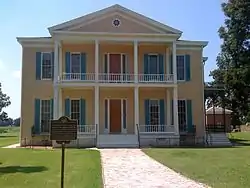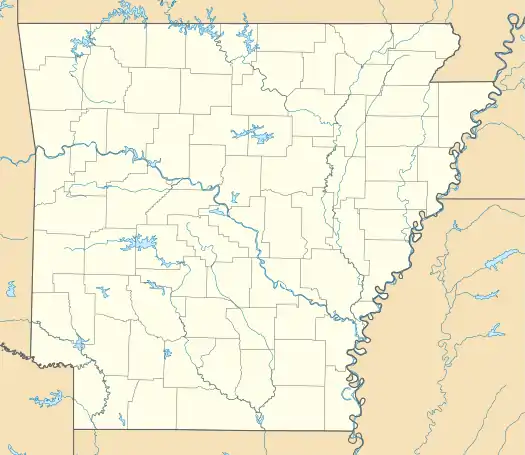Lakeport Plantation
Lakeport Plantation is a historic antebellum plantation house located near Lake Village, Arkansas. Built around 1859 it was the home of Lycurgus Johnson who owned plantation and was the son of its founder. Many enslaved people worked on the property. The house was restored between 2003 and 2008 and is now a part of Arkansas State University as a Heritage site museum.
Lakeport Plantation | |
 Lakeport Plantation, 2008 | |
 Location in Arkansas  Location in United States | |
| Nearest city | Shives, Arkansas |
|---|---|
| Coordinates | 33°15′24″N 91°9′19″W |
| Area | 5 acres (2.0 ha) |
| Built | c. 1859 |
| Architectural style | Greek Revival |
| NRHP reference No. | 74000466[1] |
| Added to NRHP | November 20, 1974 |
History
The plantation was established in 1831 by Joel Johnson, from a prominent planter family in Scott County, Kentucky. He arrived with 23 enslaved people and set up a forced labor camp to produce cotton,[2] an endeavor that made him one of the wealthiest and most influential men in the state.[3]
Joel Johnson died in 1846, leaving the plantation's ownership in legal dispute. In 1857, his son Lycurgus Johnson, a successful operator of his own forced labor camp, acquired the title to Lakeport. He also took over the enslavement of 88 people.[3] By 1850, he had 2,850 acres of land and had enslaved 95 people.[4]
The plantation's mansion was built around 1859[5][6] in the Greek Revival architectural style.[7] By 1860, owned more than 155 slaves, and forced them to work some 4,000 acres of land at Lakeport and his other Arkansas properties.[8] Records show that most of the enslaved people were field hands, but some were masons, house-hold servants, and carpenters. Plantation life was exhausting for those forced to work it; many worked six days a week with only one day off, typically Sunday.
The plantation was highly profitable as cotton prices increased with European demand, though the Civil War took a toll on Johnson's fortunes. Confederate forces burned 158 bales of the plantation's cotton in 1862 to prevent its capture by Union forces.[9]
Tax records show that by 1864 the number of people enslaved at Lakeport had declined to 24, as many former slaves fled after the Abraham Lincoln signed the Emancipation Proclamation.[10] The end of the Civil War resulted in the emancipation of the remaining enslaved people. Wile they obtained their freedom, they still held limited rights and faced continued discrimination and oppression in Arkansas. The Freedmen's Bureau was created to help freedmen, transitioning many into sharecropping and tenant farmering. Lycurgus worked closely with the Bureau and negotiated wages for the no-longer-enslaved people to labor on his plantation and continue to grow cotton.[11] Within a few years, many of the freedmen worked for Johnson either as paid laborers or as sharecroppers, as other jobs were few in the agricultural delta.[12] He became well known in the county because he managed to continue to profit despite the war and subsequent flooding and economic depression. Lakeport was among the leading cotton producers in Chicot County in 1870.[13]
The plantation went through several changes after Lycurgus Johnson died on August 1, 1876, as a result of complications from a gastrointestinal disorder.[14] His wife Lydia owned it until she died in December 1898, when it passed to the youngest son, Victor Johnson.[15] It remained in the Johnson family until 1927 when Victor sold it to the Sam Epstein family.[16]
Legacy
In 1974 the plantation was placed on the National Register of Historic Places.[17] It was donated by the Sam Epstein Angel family to Arkansas State University in 2001.[18][19]
Restoration of the plantation began in 2003 and finished in 2007. Some of the restored parts were the doors, floorcloth, mantel, trose window in the attic, and the smokehouse in the back of the property. In 2007, it opened as a public museum.[20] The plnatation house is surrounded by cotton fields that are harvested every year. [21]
See also
References
- "National Register Information System". National Register of Historic Places. National Park Service. July 9, 2010.
- Wintory, Blake. "The House that Cotton Built: Recovering African American History at Lakeport Plantation". Arkansas Review vol 40.
- DeBlack, Thomas. "Lycurgus Leonidas Johnson (1818–1876)". The Encyclopedia of Arkansas History & Culture. Retrieved 20 February 2019.
- Cobb, James C. (2002). The Southern Elite and Social Change: Essays in Honor of Willard B. Gatewood, Jr. University of Arkansas Press. ISBN 978-1-55728-720-5.
- Matthew D. Therrell and David W. Stahle, "Tree-Ring Dating of An Arkansas Antebellum Plantation House," Tree-Ring Research 68(2012): 59-67
- Thomas A. DeBlack, A Garden in the Wilderness: The Johnsons and the Making of Lakeport Plantation (Ph.D. dissertation, University of Arkansas, 1995).
- "NRHP nomination for Lakeport Plantation" (PDF). Arkansas Preservation. Retrieved 2014-04-14.
- Wintory, Blake. "The House that Cotton Built: Recovering African American History at Lakeport Plantation". Arkansas Review vol 40.
- "Timeline". The Lakeport Plantation. 2014-07-31. Retrieved 2020-05-01.
- Cobb, James C. (2002). The Southern Elite and Social Change: Essays in Honor of Willard B. Gatewood, Jr. University of Arkansas Press. ISBN 978-1-55728-720-5.
- Cobb, James C. (2002). The Southern Elite and Social Change: Essays in Honor of Willard B. Gatewood, Jr. University of Arkansas Press. ISBN 978-1-55728-720-5.
- "Lakeport Plantation timeline". Lakeport Plantation. Arkansas Heritage Sites, Arkansas State University. Retrieved 20 February 2019.
- "Encyclopedia of Arkansas". Encyclopedia of Arkansas. Retrieved 2020-05-02.
- "Encyclopedia of Arkansas". Encyclopedia of Arkansas. Retrieved 2020-04-18.
- "The Johnsons of Lakeport". The Lakeport Plantation. 2014-07-27. Retrieved 2020-04-18.
- "Encyclopedia of Arkansas". Encyclopedia of Arkansas. Retrieved 2020-03-20.
- "Encyclopedia of Arkansas". Encyclopedia of Arkansas. Retrieved 2020-05-01.
- "Timeline". The Lakeport Plantation. 2014-07-31. Retrieved 2020-05-01.
- "About". The Lakeport Plantation. 2013-08-14. Retrieved 2020-03-20.
- "Timeline". The Lakeport Plantation. 2014-07-31. Retrieved 2020-05-01.
- Cobb, James C. (2002). The Southern Elite and Social Change: Essays in Honor of Willard B. Gatewood, Jr. University of Arkansas Press. ISBN 978-1-55728-720-5.
